putterings 346 < 347 > 348 index
and compasses, and tiddle-um things; sewer systems or what not
But it was equally incontestable that he also loved his Art, which was architecture; and soon — altogether too soon — after the honeymoon wore off, his Art began to get more of him than his wife did. Finally it came to such a pass that he used to bring home fat rolls of work to a little two by four den he had up the back stairs — which he’d had laid out with draughting boards, and black ink, and red ink, and compasses, and tiddle-um things, and pencils enough to start a fire with; and there Maurel would spend the evenings that rightfully belonged to his wife in puttering about with his T-squares, hissing tuneless little catches between his teeth, and happily ruining his eyes over interminable plans till midnight.
Sometimes his wife would rustle into the room and snuggle into a corner seat back away in the darkness...
ex Frederick Kinney Noyes, “A Deal in Futures,” in The Yale Literary Magazine 72:6 (March 1907) : 222-233 : link (Michigan copy/scan, via google)
(Harvard copy/scan, via hathitrust) : link
—
initial landing, “puttering” + “rustle”) : link (Michigan copy)
—
The story concerns a young architect who loses himself in grand visions of architectural glory; his wife puts an end to these ambitions — dowses the dream, saves the marriage. Rowland was the son of a newspaper publisher, and brother of Charles F. Noyes (“prominent New York real estate operator”).
This would be the only story published by Noyes; it might just as well have been written by Helen Rowland with whom Noyes would marry in 1917. Rowland, syndicated columnist, aphorist, humorist, author of “Making a Husband out of a Man” (Vogue, May 1917; reproduced entire — minus illustrations — in The Relief Society Magazine, November 1917 : link).
More about Helen Rowland — in whose writing I find no puttering’s — below.
from the text —
for the most part her fool of a husband was so wrapped up in his sewer systems or what not (223)
“How about the sewer?” (224)
she breathed a sigh of thankfulness that at last the time of evening sewer drawing was gone. (232)
I wondered who Kinney was, and found rather more about his wife, Helen Rowland — a lot more — than about him. For instance, in a correction to a brief biography (attached to “How I would sell my books if I were a bookseller”), she writes, “My husband, at present, is Frederick Kinney Noyes, Managing Editor, Adventure Magazine.” (the marriage lasted 1917-1934)
Some digging revealed there was an earlier marriage, to William Hill Brereton ((1876-1956). I wondered, who this woman — and her husbands — were.
![]()
Frederick Noyes Kinney (1884-1941), newspaper and magazine editor
-
New York Times obituary (December 20, 1941) : link (paywall)
“Mr. Noyes’ marriage to Miss Helen Rowland ended in divorce.” - Obituary Record of Graduates of Yale University Deceased during the year 1941-1942
Bulletin of Yale University, Series 39, Number 1 (1 January 1943) : 120-121 : link
“Married June 9 1917, in New York City, Helen Irene, daughter of Joseph Lee and Irene (Chamberlain) Rowland No children Mr and Mrs Noyes were divorced in 1934”The Yale obituary lists his various reporter, editing and other roles with the New York Sun, The Volta Review; Adventure; Munsey’s Magazine and All-Story Weekly; Argosy and Railroad Man’s Magazine; Delineator; etc.
One of these was Teaching material in government publications, compiled by Frederick K. Noyes, U.S. Bureau of Education, Bulletin, 1913, No. 47 (1913) : link
same, via google : link
... my kind of thing

Helen Rowland (1875-1950), syndicated columnist, much-quoted humorist, aphorist
- wikipedia : link
- “Making a Husband Out of a Man”
Making a living, making a career, making a fortune, or making fame is not the forte of a woman; It is making a husband out of a mere man.
By Helen Rowland, Vogue (May 1917) : link (inaccessible, paywalled)but evidently full text (minus illustration, layout) at
Relief Society Magazine 4:11 (November 1917) : 611-615
“Owned and published by the General Board of the Relief Society of the Church of Jesus Christ of Latter-day Saints”
link (google books)
same (hathitrust) - “Her beaux started Helen Rowland on career as ‘Solomon’s Wife’”
Knows all men by knowing one well and is most popular of women newspaper writers among the “Brutal Sex”
by Rosalie Armistead Higgins, in Editor & Publisher, (April 17, 1920) : 8, 58 : link
same, via google books : link
features a cartoon headlined “Men are incidental in Helen Rowland’s young life” (with large center image and multiple captioned vignettes surrounding it, each on a different aspect of Rowland’s career) in the style of his usual work on sports subjects by Ed Hughes —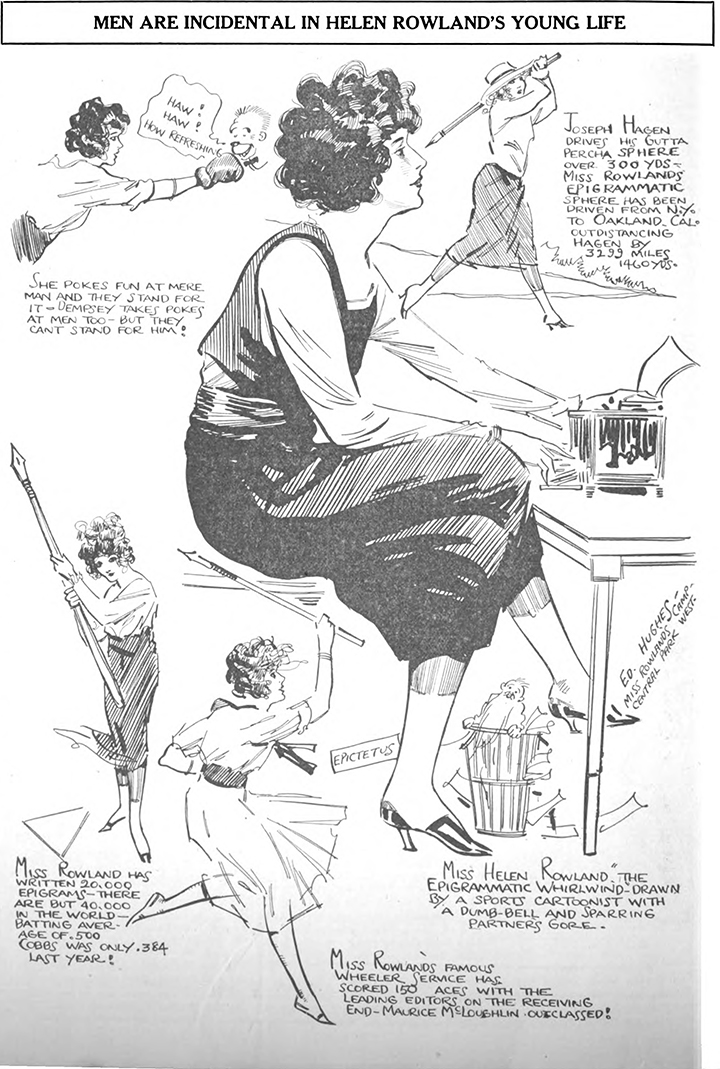

her books (and their dedications)
- Reflections of a Bachelor Girl (New York, The Van Wagenen Company, 1903)
cannot find online, but at LoC : link
the book is noticed at Book News (Philadelphia, January 1904) : 665 —
“Brief apothegms which appeared in the New York Press dealing with the weaker side of men and women, touched with a little cynicism and occasionally lapsing into vulbarity. 150pp. 32mo.”
and syndicated excerpts can be found here and there, e.g.,
The Wetaskiwin Times (Wetaskiwin, Alberta; August 2, 1901) link, e.g.,
“Patience is unravelled hope,” and
“You can always tell just what’s going to happen to a fool till something else does.”Perhaps inspired (or instigated) by Reflections of a Bachelor; by P. W.; illustrated by Charles Dana Gibson (New York, J. S. Ogilvie, 1897) : link (Harvard copy/scan, via hathitrust)
P. W. was George Post Wheeler (1869-1956), journalist, writer, diplomat : wikipedia : link
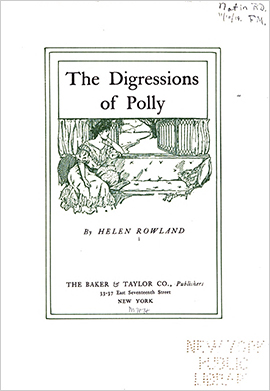
Helen Rowland, The Digressions of Polly; illustrations by Mary Ponton Gardner [not credited on title page] (New York; Baker & Taylor, 1905)
link (NYPL copy/scan, via hathitrust)dedication : none

Helen Rowland, The Widow; to Say Nothing of the Man; illustrated by Esther P. Hill (Dodge, 1908)
link (Harvard copy/scan, via hathitrust, where UC copy also available)dedication : none
an idea to be developed throughout Rowland’s work is found at p 128 — “making a husband — out of a man,” which is described as more the forte of women than making a living, or career, or fame or fortune.

Helen Rowland, Reflections of a Bachelor Girl, “decorated” by Henry S. Eddy (New York: Dodge Publishing, 1909)
link (U Wisconsin-Madison copy/scan, via hathitrust)dedication : none
title page epigram : “‘Just once more’ is the Devil’s best argument.”

Helen Rowland, The Sayings of Mrs. Solomon : Being the confessions of the seven hundredth wife as revealed to Helen Rowland... (New York: Dodge Publishing, 1913)
link (U Wisconsin-Madison copy/scan, via hathitrust, where other scans available)dedication : none
(quite nice) interior art by PAUS, presumably Herbert Paus (1860-1945)
wikipedia : link American Art Archives : link
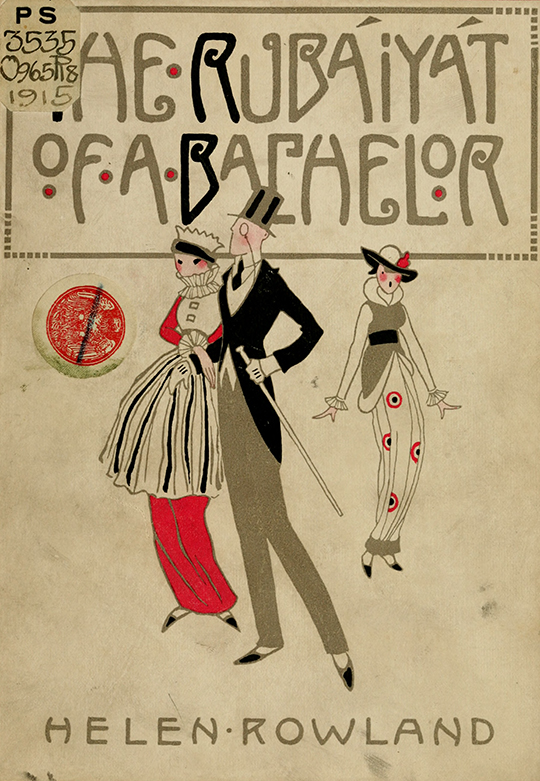
Helen Rowland, The Rubaiyat of a Bachelor, “Decorations by Harold Speakman” (1915)
link (LoC copy, among several at hathitrust)dedication :
To my husband
William Hill-Brereton
this little book is affectionately dedicatedHarold Speakman (1888-1928) : wikipedia : link
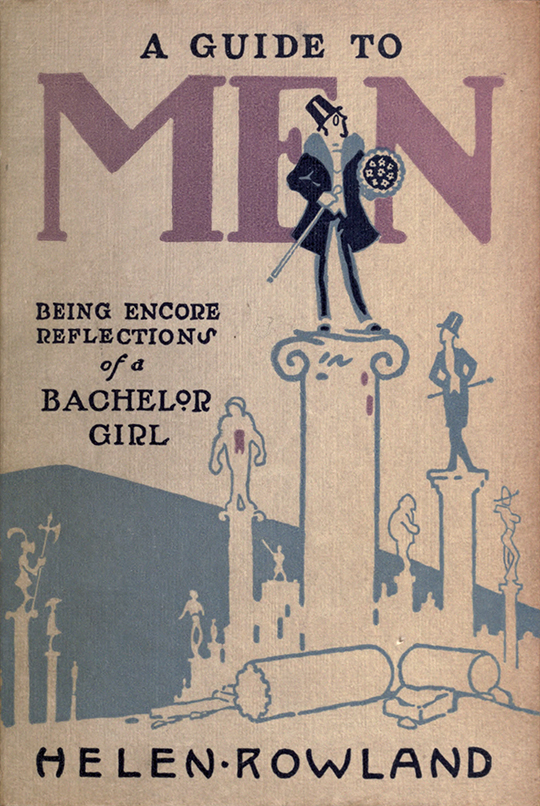
Helen Rowland, A Guide to Men, Being encore reflections of a bachelor girl; illustrations by Harold Speakman (Dodge, 1922)
link (UCLA copy/scan, via hathitrust)dedication :
To Fannie Hurst
Who has discovered the secret of how to be happy, though wedded to an art and to a man at the same time.
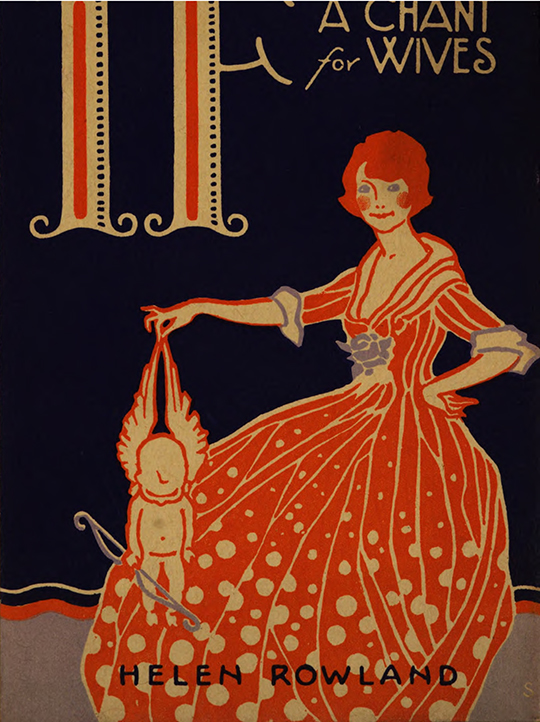
Helen Rowland , “If” : also : The White Woman’s Burden; drawings by Harold Speakman (Dodge, 1927)
link (U Wisconsin copy; cover cut off at top)dedication : To Disgruntled Wives
The following parodies on two of Rudyard Kipling’s most familiar poems, “If” and “The White Man’s Burden,” are offered in response to many requests from women readers — presumably wives, who find in them a sympathetic note, and an opportunity to “hold the mirror up to nature.”
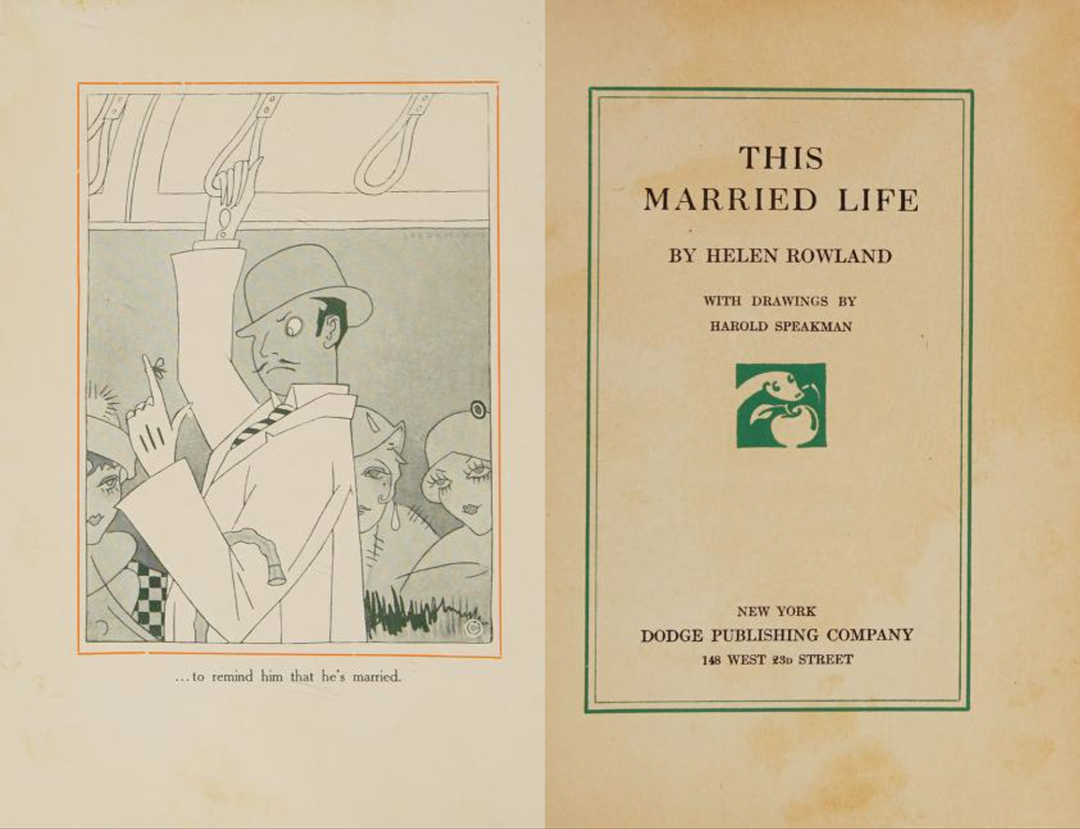
Helen Rowland, This Married Life (1927)
link (archive.org)dedication :
To all those who are outside the bonds of matrimony, and striving to get in — and to all those who are inside, and struggling to get out,
To all those who look forward to marriage as an Ideal — and to all those who look back upon it as an Ordeal,
To all those who hunger for love — and to all those who are “fed up” with it,
To all husbands, including your husband, and my husband,
And to every “Rib,” since Eve,
This book is tenderly Dedicated, H.R.

Helen Rowland, other than books
- Helen Rowland, “The Emancipation of ‘The Rib’ — Woman now shares equal honors with man in seeing a joke — and sometimes sees it first”
The Delineator 77:3 (March 1911) : 176, 231-232
link (google books)
link (hathitrust; both U Iowa copy/scan, poor quality)The books came from the regular flow of copy in Rowland’s syndicated columns.
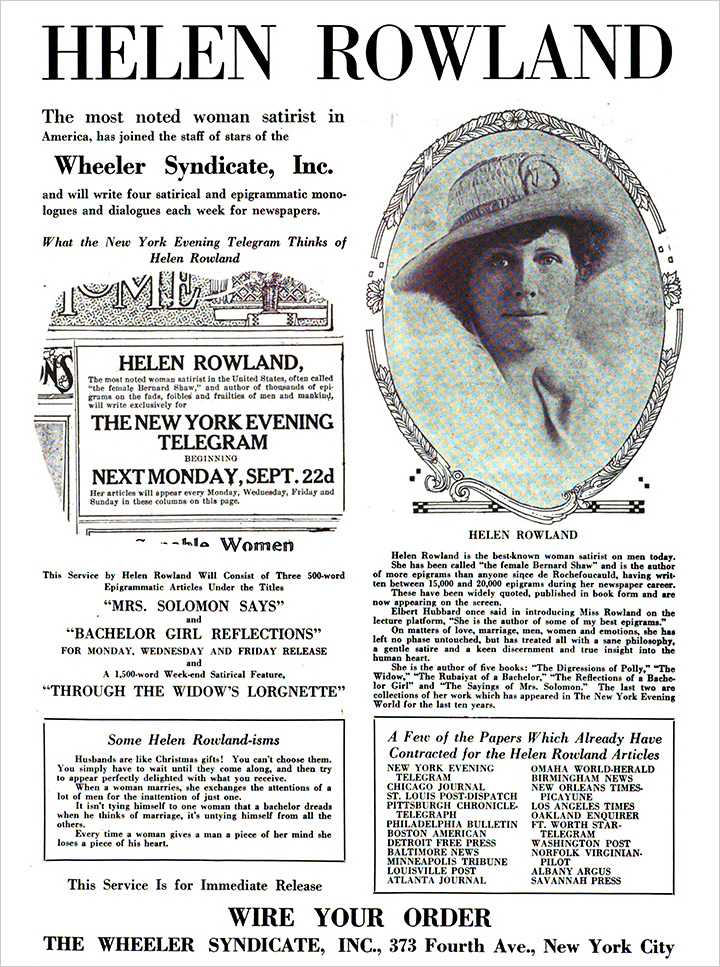
announcement in Editor & Publisher 52:17 (September 25, 1919) : 23 : link
- Helen Rowland, “How I would sell my books if I were a bookseller”
The Bookseller and Stationer 56:8 (April 15, 1922) : 8 : linkRowland’s letter (of corrections) to editor (May 1, 1922) : link
aside —
anticipates the type-casting her writing would later be subjected to in surveys of feminist and women’s writingIn that letter of correction, Howland writes —
“As for Mr. Alfred Noyes, I have not married him — thus far.
But Rome wasn’t built in a day. My husband, at present, is Frederick Kinney Noyes, Managing Editor, Adventure Magazine.”
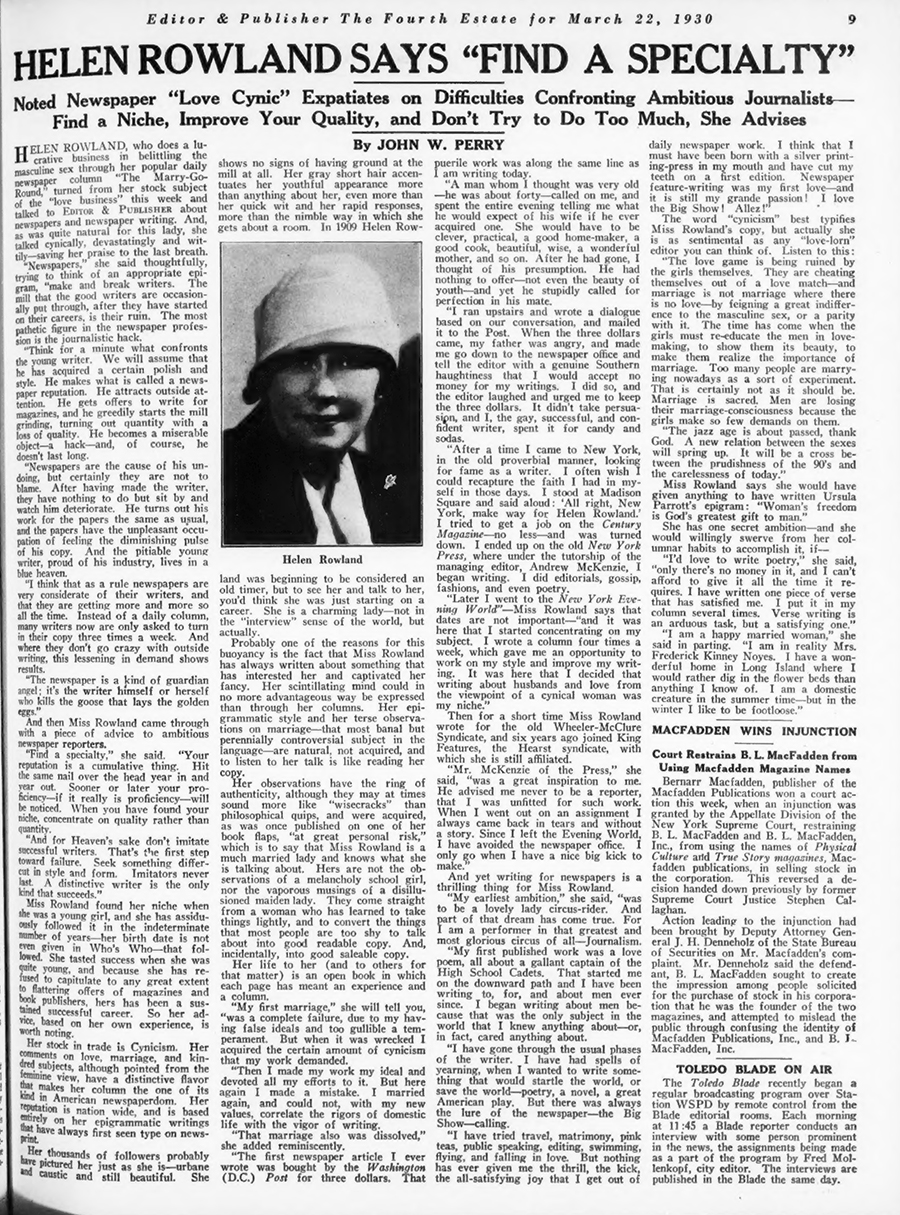
John W. Berry, “Helen Rowland Says Find a Speciality”
Noted newspaper "love cynic" expatiates on difficulties confronting ambitious journalists — find a niche, improve your quality, and don't try to do too much, she advises."
Editor & Publisher 62:44 (March 22, 1930) : 9
link (archive.org, from which the above illegal screen grab)Talks about her first husband, and the second; but above all, her writing career.
thanks to mention (initially of Rosalie Armistead Higgins, who profiled Rowland in 1920) in Will Mari, The American Newsroom : A History, 1920-1960 (2021) : link
- Helen Rowland, “What To Do Till The Lawyer Comes”
Legal Chatter 1:7 (February 1938) : 43-44generally inaccessible, but here’s a transcription —
Almost everybody knows, by this time, what to do till the doctor comes; but, as yet, nobody has told a panting public what to do till the lawyer comes.
That is the dangerous interlude when the average woman in pre-divorce mood makes her worst mistakes — mistakes often as fatal as applying hot-compresses instead of an ice-bag.
A woman has always got to do something! And, in that flighty moment before she has consulted an attorney, she is likely to rush into all sorts of foolish things, from tears, threats and recriminations, to calling in the reporters and spilling the beans all over the carpet.
The first thing to do when you feel a divorce coming on is to stop the flow of your emotions and use a pulmotor on your common sense. Then you can sit down and calmly DIAGNOSE yourself.
Ask yourself if you are really serious — or if this is just a gesture.
Do you really want to get rid of him — or do you only want to get rid of the other woman? Or of counting his laundry and keeping a budget?
How much alimony do you want? And how much has he GOT?
Are you in love with another man — or is it only boredom, vanity or a touch of the spring wanderlust? Or your liver? Try taking dandelion tea to clear up your vision.
Try to visualize yourself signing your own dinner checks and taking yourself to movies. Decide, once and for all, whether you prefer eating alone in a restaurant — or scrapping across a nice, home cooked dinner. Waiting for a tardy husband — or waiting for an uncertain boy friend to telephone you?
Take you temperature and find out whether it is just an overheated temper or a real case of chilled love which has genrated the divorce-germ.
Think over the different “grounds” on which you can divorce him — and select the most POLITE one. But never mind! Your lawyer will probably call it “Mental Cruelty,” no matter what you decide."
Decide what KIND of divorce you want — whether a nice, quiet, friendly, little collusive affair with manufactured evidence, or a big court battle with plenty of Front Page publicity. There are SO Many varieties!
Oh, yes, there are lots of things to do till the lawyer comes. And by the time you have tried them all you probably won’t want him!

William Hill Brereton (1876-1956), writer, stenographer/phonographer ?
- His Find a Grave entry (link) has Brereton born in England, death in Asheville, North Carolina. His gravestone has his and Helen Rowland’s name and years. Her entry (link) states that she also died in Asheville (1950).
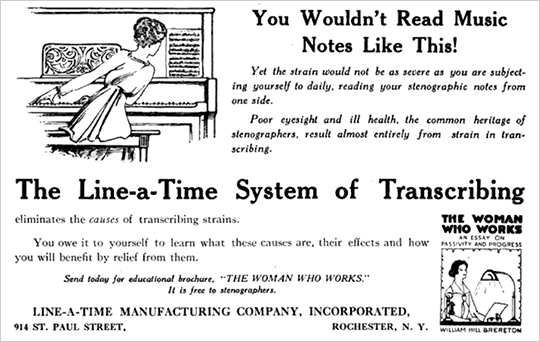
advertisement in Stenographer and Phonographic World 46:1 (January 1917) : 30 : link (google books)
see also advertorial under the heading “Brevities” —
“The Woman Who Works: An Essay on Passivity and Progress” is an attractive booklet written by Mr. William Hill Brereton and published by the Line-a-time Manufacturing Company, of Rochester, New York. It tells of some women whose salaries are $10,000 a year and more, and it gives some reasons why there are not more of them. The ambitious business men or women and the young people who are ambitious to become successful business men and business women will find Mr. Brereton’s message of interest. This booklet is being distributed to stenographers without charge.
in The Gregg Writer 19:7 (March 15, 1917) : 340
link
change, subject to.